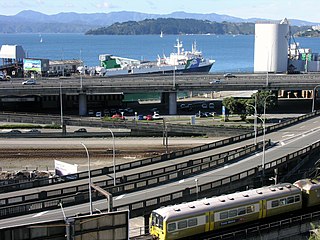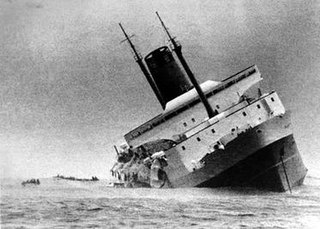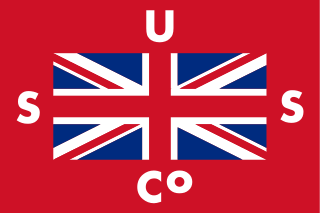
Mullogh was a ketch rigged steam ship, built in 1855 in Belfast. It sailed to Australia, then to New Zealand. The wreck of Mullogh is now beached on Quail Island.

Mullogh was a ketch rigged steam ship, built in 1855 in Belfast. It sailed to Australia, then to New Zealand. The wreck of Mullogh is now beached on Quail Island.
Mullogh was built by Coates & Young, a Belfast foundry on Queen's Island in the River Lagan. It was 60 ft long, beam 15 ft, weighing 69.39 tons gross, 46.13 tons net. [1]
The vessel was equipped with a 15 hp steam engine driving a propeller. Mullogh was completed in the same year that the modern propeller was patented by Robert Griffiths, making it one of the earliest known propeller-driven vessels. [1]
In 1857, Mullogh sailed to Melbourne, Australia, where it was used in for trading up and down the Victoria and New South Wales coast. [2]
In 1859, Richard Dalgety, the man in charge of the port of Lyttelton, New Zealand needed a small steam powered vessel to service ships arriving at Lyttelton Harbour, taking cargo and passengers from ships berthed in the harbour to shore, and also to use as a tug when the wind was unsuitable for sailing into or out from the harbour. Such vessels were not readily available in New Zealand at this time, and Dalgety sourced Mullogh from Australia. On 1 June 1859, Mullogh was purchased by Dalgety along with John Maclean, a Christchurch merchant, for £1,600.
After a 22 day voyage, Mullogh arrived in Lyttelton on 29 June 1859 with a cargo of bricks. The vessel was sailed to New Zealand with the funnel and propeller in the hold.
For the next forty years, Mullogh transported cargo and passengers around the Canterbury region. Two trips were made to take supplies to the gold mines of the West Coast. Much of the cargo transported to Lyttelton from overseas was either towed or landed by the Mullogh, including the first steam locomotive in New Zealand in 1863, [3] and the statue of John Robert Godley in 1867. [1]
In 1900, the vessel's masts were removed and Mullogh was used as a fishing trawler from Lyttelton until 1912, when the vessel moved to Timaru. [4] [5]
Mullogh was still in survey in 1922, but in 1923 she was stripped and beached on Quail Island.
The beached remains of Mullogh remain on Quail Island, with the prominent boiler easily visible. [6]

Transport in New Zealand, with its mountainous topography and a relatively small population mostly located near its long coastline, has always faced many challenges. Before Europeans arrived, Māori either walked or used watercraft on rivers or along the coasts. Later on, European shipping and railways revolutionised the way of transporting goods and people, before being themselves overtaken by road and air, which are nowadays the dominant forms of transport. However, bulk freight still continues to be transported by coastal shipping and by rail transport, and there are attempts to (re)introduce public transport as a major transport mode in the larger population centres.

Sumner is a coastal seaside suburb of Christchurch, New Zealand and was surveyed and named in 1849 in honour of John Bird Sumner, the then newly appointed Archbishop of Canterbury and president of the Canterbury Association. Originally a separate borough, it was amalgamated with the city of Christchurch as communications improved and the economies of scale made small town boroughs uneconomic to operate.

A scow is a type of flat-bottomed barge. Some scows are rigged as sailing scows. In the 19th and early 20th centuries, scows carried cargo in coastal waters and inland waterways, having an advantage for navigating shallow water or small harbours. Scows were in common use in the American Great Lakes and other parts of the U.S., in southern England, and in New Zealand. In Canada, scows have traditionally been used to transport cattle to the islands of New Brunswick's Saint John River. In modern times their main purpose is for recreation and racing.

TEV Wahine was a twin-screw, turbo-electric, roll-on/roll-off ferry. Ordered in 1964, the vessel was built by the Fairfield Shipbuilding and Engineering Company, in Govan, Glasgow, Scotland for the Union Steam Ship Company's Wellington-Lyttelton Steamer Express Service in New Zealand. The ship's name, Wahine, is a word for 'woman in some Polynesian languages, such as spoken by the Māori.

Lyttelton is a port town on the north shore of Lyttelton Harbour, at the northwestern end of Banks Peninsula and close to Christchurch, on the eastern coast of the South Island of New Zealand. According to the 2013 census, Lyttelton had a usual resident population of 2,859.

Quail Island is an 81 ha uninhabited island within Lyttelton Harbour in the South Island of New Zealand, close to Christchurch. The island was given its European name by Captain William Mein Smith who saw native quail here in 1842; though they were already extinct by 1875. Ōtamahua means 'the place where children collect sea eggs'. Te Kawakawa refers to the pepper trees found on the island.
USS Glacier (AGB-4) was a U.S. Navy, then U.S. Coast Guard icebreaker which served in the first through fifteenth Operation Deep Freeze expeditions. Glacier was first icebreaker to make her way through the frozen Bellingshausen Sea, and most of the topography in the area is named for her crew members. When built, Glacier had the largest capacity single armature DC motors ever installed on a ship. Glacier was capable of breaking ice up to 20 feet (6.1 m) thick, and of continuous breaking of 4-foot (1.2 m) thick ice at 3 knots.

GMV Aramoana was a roll-on/roll-off train ferry operating across Cook Strait between 1962 and 1983.

Interislander is a road and rail ferry service across New Zealand's Cook Strait, between Wellington in the North Island and Picton in the South Island. It is owned and operated by state-owned rail operator KiwiRail. Three roll-on roll-off (RORO) vessels operate the 50-nautical-mile route, taking about three hours to complete the crossing.

Lyttelton Harbour / Whakaraupō is one of two major inlets in Banks Peninsula, on the coast of Canterbury, New Zealand; the other is Akaroa Harbour on the southern coast.
The technique of composite ship construction emerged in the mid-19th century as the final stage in the evolution of fast commercial sailing ships.

Union Steam Ship Company of New Zealand Limited —when there was no chance of confusion casually referred to as Union, Union Company, Union Steam Ship Company, or Union Line— was once the biggest shipping line in the southern hemisphere and New Zealand's largest private-sector employer. It was incorporated by James Mills in Dunedin in 1875 with the backing of a Scottish shipbuilder, Peter Denny. Bought by shipping giant P & O around the time of the First World War it was sold in 1972 to an Australasian consortium and closed at the end of the twentieth century.

HMS Defender was a second-class colonial-service torpedo boat built in 1883 for service in New Zealand and abandoned at Lyttelton sometime after 1900. Her remains are today displayed at the Lyttelton Torpedo Boat Museum.

Akaroa Harbour, is part of Banks Peninsula in the Canterbury region of New Zealand. The harbour enters from the southern coast of the peninsula, heading in a predominantly northerly direction. It is one of two major inlets in Banks Peninsula, on the coast of Canterbury, New Zealand; the other is Lyttelton Harbour on the northern coast.
TEV Rangatira was a roll-on/roll-off vehicle and passenger ferry launched in 1971 for the Union Steam Ship Company of New Zealand. She is significant for having been the World's last surviving passenger ship with steam-powered turbo-electric transmission.
Matoaka was a 1092-ton wooden New Brunswick full-rigged ship built in 1853 for Willis, Gunn, & Co. She was sold to Shaw, Savill, & Albion by 1859. Between 1859 and 1869 she made eight voyages to New Zealand. Her fastest run from Bristol to Lyttelton, New Zealand was 82 days in 1862. On 13 May 1869 she left Lyttelton for London under Captain Alfred Stevens with 45 passengers and 32 crew but was never seen again. In 1865 she was classed as 1322 tons.

The Northern Steam Ship Company Ltd (NSS) served the northern half of the North Island of New Zealand from 1881 to 1974. Its headquarters, the Northern Steam Ship Company Building, remains in use on Quay St, Auckland as a bar.
Novelty was a barque-rigged iron paddle steamer, built at Sydney in 1863.

Darra was a barque-rigged clipper, built at Aberdeen and launched in 1865.
Dolphin was a New Zealand cutter of 10 tons.